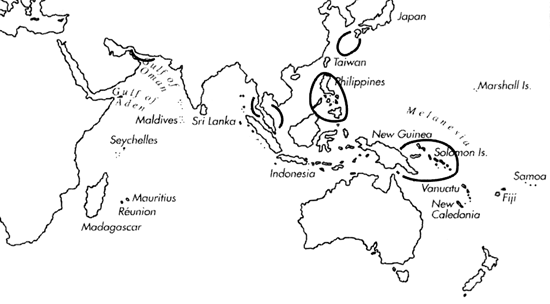Range: Type locality, W. Thailand, and N. E. Malaysia; Ryukyu Is., Philippines, Solomon Is., and Papua New Guinea.
Description: Small to medium sized, light to moderately light. Last whorl narrowly conical to conical, sometimes approaching pyriform; right side nearly straight in outline, occasionally slightly concave at base; left side usually concave in outline, sometimes straight to slightly convex below shoulder. Siphonal canal often deflected to the dorsal side. Shoulder sharply angulate to carinate, with a deep exhalent notch. Spire of moderate height to high, usually stepped; outline concave. Larval shell of 3-3.5 whorls, maximum diameter 0.8-0.9 mm. First 5-8 postnuclear whorls tuberculate. Teleoconch sutural ramps slightly concave, with radial threads crossing 0-1 increasing to 3-6 spiral grooves. Entire last whorl with weak axially striate spiral grooves separating distinct ribs at base, narrow ribbons below shoulder and wider ribbons inbetween.
| Shell Morphometry | ||
|---|---|---|
| L | 23-40 mm | |
| RW | 0.03-0.08 g/mm | |
| (L 23-36 mm) | ||
| RD | 0.45-0.59 | |
| PMD | 0.86-0.96 | |
| RSH | 0.14-0.28 | |
Ground colour white, usually suffused with grey. Last whorl with spiral rows of yellowish brown to dark brown dots, spots and bars fusing into 2-4 spiral bands, below shoulder, at base and on both sides of centre; the central bands are most consistently present. Some shells have pronounced spiral rows of brown dots and dashes from base to shoulder; some rows with distinct white articulations. Shoulder usually with a row of widely spaced reddish brown dots. Largely white shells with sparse ornamentation on last whorl intergrade with heavily maculated shells. Larval whorls usually beige to light brown. Postnuclear sutural ramps with yellowish brown to dark brown radial markings, sometimes producing regularly spaced dark dots at outer margin. Aperture translucent or white.
Periostracum yellowish grey, thin, translucent, smooth.
Radular teeth very similar to those of C. comatosa, but base and basal spur smaller (Rolán, pers. comm., 1992).
Habitat and Habits: Type specimens (Pl. 56, Figs. 21, 22) in 85-90 m; Pacific shells usually from 100-400 m.
Discussion: C. saecularis is most similar to the larger C. comatosa (to 50 mm), and small individuals of the two species from Philippines are difficult to distinguish. C. comatosa has a rather pyriform last whorl with a mostly more convex outline adapically; the position of the maximum diameter is generally located closer to the base (PMD 0.78-0.88), and the left side is concave only basally. Its last whorl pattern has usually 4 spiral colour bands, its ground colour is white rather than shaded with grey, and its larval shell is broader (1.1 mm) and white rather than beige to light brown. For comparison with C. insculptus, see the Discussion of that species.

C. saecularis range map
This section contains verbatim reproductions of the accounts of 316 species of Conus from the Indo-Pacific region, from Manual of the Living Conidae, by Röckel, Korn and Kohn (1995). They are reproduced with the kind permission of the present publisher, Conchbooks.
All plates and figures referred to in the text are also in Röckel, Korn & Kohn, 1995. Manual of the Living Conidae Vol. 1: Indo-Pacific Region.
The range maps have been modified so that each species account has it own map, rather than one map that showed the ranges of several species in the original work. This was necessary because each species account is on a separate page on the website and not confined to the order of accounts in the book.